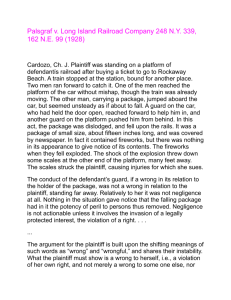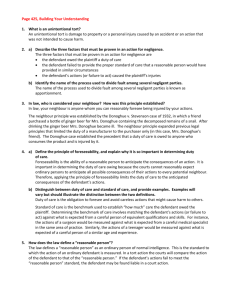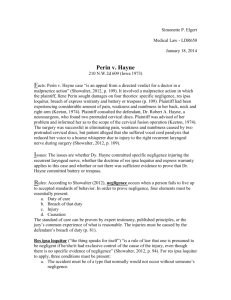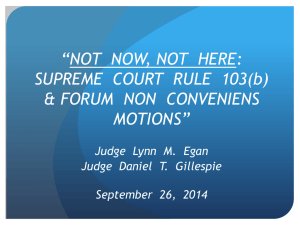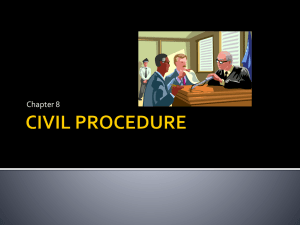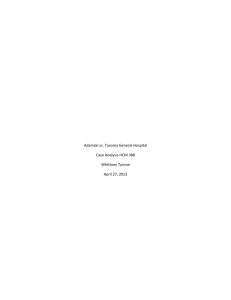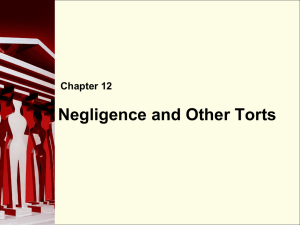Powerpoint for Chapter 6
advertisement
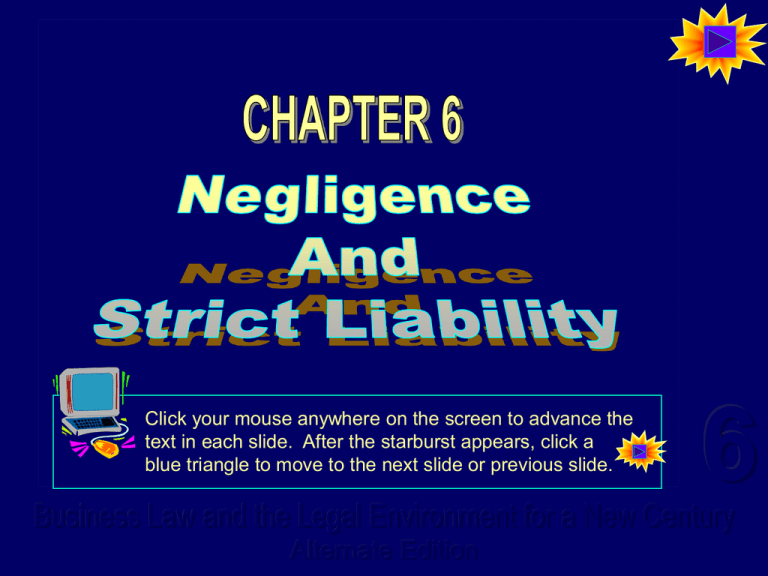
Click your mouse anywhere on the screen to advance the text in each slide. After the starburst appears, click a blue triangle to move to the next slide or previous slide. 6 Business Law and the Legal Environment for a New Century Alternate Edition Quote of the Day “The life of the law has not been logic; it has been experience.” Oliver Wendell Holmes, Jr., Supreme Court Justice 6 Business Law and the Legal Environment for a New Century Alternate Edition Negligence -- “The Unintentional Tort” To win a negligence case, the plaintiff must prove that the defendant failed in five areas: Duty of due care -- there must be a duty owed to the plaintiff. Breach -- duty must be breached. Factual cause -- the injury must have been caused by the defendant’s actions. Foreseeable harm -- it must have been foreseeable that the action would cause this kind of harm. Injury -- the plaintiff must have been hurt. 6 Business Law and the Legal Environment for a New Century Alternate Edition Breach of Duty A defendant breaches his duty of due care by failing to behave the way a reasonable person would under similar circumstances. Companies and Employees -- courts have found companies liable for hiring and retaining employees known to be violent, when those employees later injured co-workers. Negligence per se -- in special cases, legislatures set a minimum standard for certain groups of people (esp. children). When a violation of that statute hurts a member of that group, the duty is breached. 6 Business Law and the Legal Environment for a New Century Alternate Edition Factual Cause & Foreseeable Harm Factual Cause -- if the defendant’s breach ultimately led to the injury, he is liable. • Does not have to be the immediate cause of injury, but must be the first in the direct line. Foreseeable Harm -- to be liable, this type of harm must have been foreseeable. • The defendant does not have to know exactly what would happen -- just the type of event. Res Ipsa Loquitur -- in a few cases, the defendant must prove he was NOT negligent or the facts imply that his negligence caused the injury. 6 Business Law and the Legal Environment for a New Century Alternate Edition Example: Factual Cause & Foreseeable Harm Mechanic fails to fix customer’s brakes, which causes... Car accident, car hitting bicyclist Car accident, car does not hit bicyclist Car accident, car hitting bicyclist Noise from accident startles someone who falls out a window Bicyclist hits pothole and crashes Mechanic is liable to cyclist Mechanic is NOT liable for falling person Mechanic is NOT liable to cyclist Factual cause and foreseeable type of injury Factual cause, but no foreseeable type of injury No factual cause 6 Business Law and the Legal Environment for a New Century Alternate Edition Injury & Damages Injury -- plaintiff must show genuine injury • Future injury may be compensated, but must be determined at the time of trial. A bystander, unharmed physically, may recover for emotional distress if... • She was near the scene of the injury, • Seeing the injury caused immediate shock, and • She is a close relative of the (physical) victim Damages -- are usually compensatory, designed to restore what was lost. In unusual cases, they may be punitive. 6 Business Law and the Legal Environment for a New Century Alternate Edition Negligence Contributory Negligence • In a few states, if the plaintiff is AT ALL negligent, he cannot recover damages from the defendant. Comparative Negligence • In most states, if the plaintiff is negligent, a percentage of negligence is applied to both the defendant and the plaintiff. • The plaintiff can recover from the defendant to the percentage that the defendant is negligent. • In some cases, a plaintiff found to be more than 50% negligent cannot recover at all. 6 Business Law and the Legal Environment for a New Century Alternate Edition Strict Liability Some activities are so dangerous that the law imposes a high burden on them. This is called strict liability. Defective Products-- may incur strict liability. Ultrahazardous Activities -- defendants are virtually always held liable for harm. • What is ultrahazardous? Includes using harmful chemicals, explosives and keeping wild animals. • Plaintiff does not have to prove breach of duty or foreseeable harm. • Comparative negligence does not apply -defendant engaging in ultrahazardous activity is wholly liable. 6 Business Law and the Legal Environment for a New Century Alternate Edition “When someone’s person or property is hurt, how far should society extend liability? The law has struggled for centuries to find compensation for the injured without making every citizen the insurer of all others.” 6 Business Law and the Legal Environment for a New Century Alternate Edition

